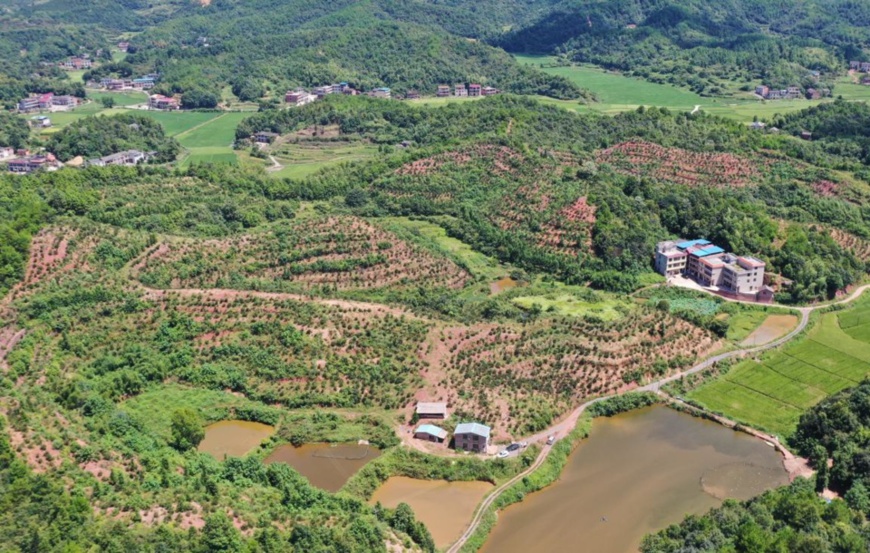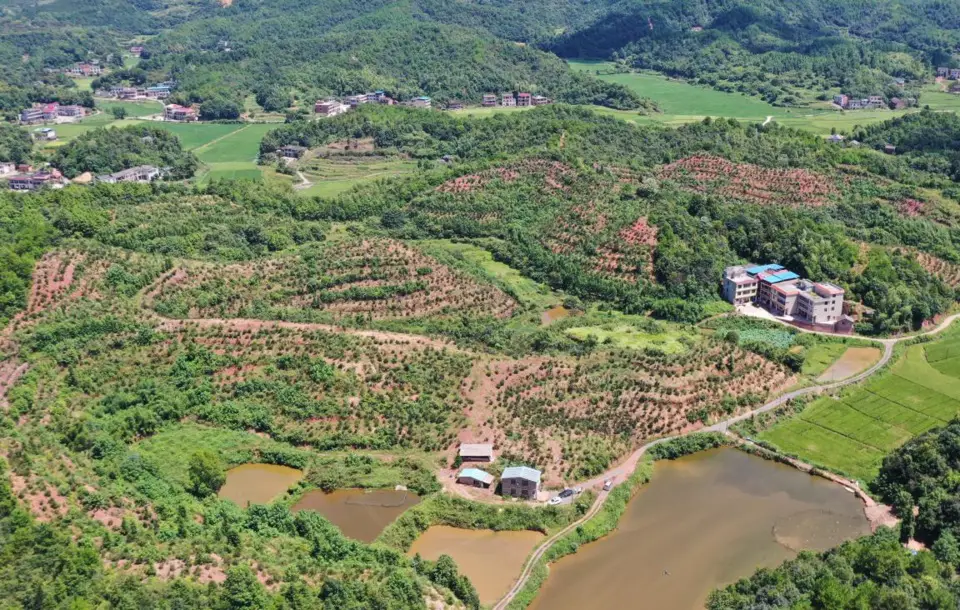By He Yong, People's Daily Online

Photo taken on Aug. 7, 2020 shows a poverty alleviation camellia oleifera plantation in Dongjing village, Lanlong Township, Hengyang, central China's Hunan Province. (Photo by Liu Xinrong/People's Daily Online)
As the spring returns, hills in Hengyang, central China's Hunan Province, are turned again into a sea of green, stretching afar with ups and downs.
"The woods you see include ecological forests, as well as camellia oleifera," said He Enguang, deputy mayor of Hengyang.
Working vigorously to develop the camellia oleifera industry in recent years, the city now has nearly 4.5 million mu (300,000 hectares) of such plants. They have turned barren mountains into vast greenness that bears huge economic potential, laying a solid foundation for the promotion of the rural vitalization strategy.
Guihua village of Hengyang's Da'an Township had abundant hillside fields, but limited arable land. The red soil on nearby mountains is ideal for growing camellia oleifera, so the local government believes that camellia oleifera planting would be a great business to expand residents' income.
However, most of the villagers were skeptical about it. They thought that land reclamation was costly, and it was a slow process requiring much labor input. "We can't get any return in the first five years, so why should we do it?"
To mobilize residents' enthusiasm, officials of the Da'an Township government visited the residents door-to-door to persuade them to join.
"The climate and soil are perfect for growing camellia oleifera. Though it takes five years to see the first batch of fruits, the business might bring decades of harvests," the officials said.
To eliminate the doubts of the residents, the officials invited entrepreneurial leaders from other regions who became well-off after planting camellia oleifera to share their experiences. Besides, they also offered training courses in villages, introduced leading enterprises in the industry, and established a cooperative for demonstration.
Finally, the township established its first 1,000-mu camellia oleifera plantation. Later, more and more villagers were mobilized, and the plant now covers over 8,000 mu of land in the township, making barren mountains a "gold mine" for the residents.
Zhang Qiufeng is a farmer from Bajiao village, Dashi Township of Leiyang, Hunan Province. She could only earn around 1,000 yuan ($153) a year by growing corns in the past. Riding on the wave of the camellia oleifera industry, she joined a professional cooperative of the village and planted camellia oleifera in all of her 10 mu of land. Two years ago, her family bid farewell to poverty.
"The cooperative offers seedlings and fertilizers, and helps us sell the products, which makes it easier for us. I earned a net income of nearly 30,000 yuan last year," Zhang said.
At present, the total area of poverty alleviation camellia oleifera plantations in Hengyang adds up to 93,800 mu, and 42,400 households were lifted out of poverty because of this business.
To further drive the development of the industry, Hengyang introduced a number of enterprises on the industrial chain, from oil manufacture to refining. Camellia oleifera has been made into natural skincare products and cleansing products. So far, the industry can generate an annual revenue of nearly 22 billion yuan for Hengyang.
In recent three years, Hengyang covered nearly 700,000 mu of slopes and cutover lands with camellia oleifera. For instance, a plantation in Donghuwei Township, Leiyang, was a cluster of coal mines years ago, but now it is a picturesque place covered by rows of camellia oleifera.
Ping'an village, Xiling Township of Changning, relying on the camellia oleifera industry, has been working to exploit cultural and tourism resources. It has transformed itself into a featured tourism destination that attracted 500,000 visits last year, lifting a total of over 2,000 residents out of poverty.
"The woods you see include ecological forests, as well as camellia oleifera," said He Enguang, deputy mayor of Hengyang.
Working vigorously to develop the camellia oleifera industry in recent years, the city now has nearly 4.5 million mu (300,000 hectares) of such plants. They have turned barren mountains into vast greenness that bears huge economic potential, laying a solid foundation for the promotion of the rural vitalization strategy.
Guihua village of Hengyang's Da'an Township had abundant hillside fields, but limited arable land. The red soil on nearby mountains is ideal for growing camellia oleifera, so the local government believes that camellia oleifera planting would be a great business to expand residents' income.
However, most of the villagers were skeptical about it. They thought that land reclamation was costly, and it was a slow process requiring much labor input. "We can't get any return in the first five years, so why should we do it?"
To mobilize residents' enthusiasm, officials of the Da'an Township government visited the residents door-to-door to persuade them to join.
"The climate and soil are perfect for growing camellia oleifera. Though it takes five years to see the first batch of fruits, the business might bring decades of harvests," the officials said.
To eliminate the doubts of the residents, the officials invited entrepreneurial leaders from other regions who became well-off after planting camellia oleifera to share their experiences. Besides, they also offered training courses in villages, introduced leading enterprises in the industry, and established a cooperative for demonstration.
Finally, the township established its first 1,000-mu camellia oleifera plantation. Later, more and more villagers were mobilized, and the plant now covers over 8,000 mu of land in the township, making barren mountains a "gold mine" for the residents.
Zhang Qiufeng is a farmer from Bajiao village, Dashi Township of Leiyang, Hunan Province. She could only earn around 1,000 yuan ($153) a year by growing corns in the past. Riding on the wave of the camellia oleifera industry, she joined a professional cooperative of the village and planted camellia oleifera in all of her 10 mu of land. Two years ago, her family bid farewell to poverty.
"The cooperative offers seedlings and fertilizers, and helps us sell the products, which makes it easier for us. I earned a net income of nearly 30,000 yuan last year," Zhang said.
At present, the total area of poverty alleviation camellia oleifera plantations in Hengyang adds up to 93,800 mu, and 42,400 households were lifted out of poverty because of this business.
To further drive the development of the industry, Hengyang introduced a number of enterprises on the industrial chain, from oil manufacture to refining. Camellia oleifera has been made into natural skincare products and cleansing products. So far, the industry can generate an annual revenue of nearly 22 billion yuan for Hengyang.
In recent three years, Hengyang covered nearly 700,000 mu of slopes and cutover lands with camellia oleifera. For instance, a plantation in Donghuwei Township, Leiyang, was a cluster of coal mines years ago, but now it is a picturesque place covered by rows of camellia oleifera.
Ping'an village, Xiling Township of Changning, relying on the camellia oleifera industry, has been working to exploit cultural and tourism resources. It has transformed itself into a featured tourism destination that attracted 500,000 visits last year, lifting a total of over 2,000 residents out of poverty.
 Menu
Menu
 Camellia oleifera lifts environment, brings economic benefits to residents in central China
Camellia oleifera lifts environment, brings economic benefits to residents in central China
















